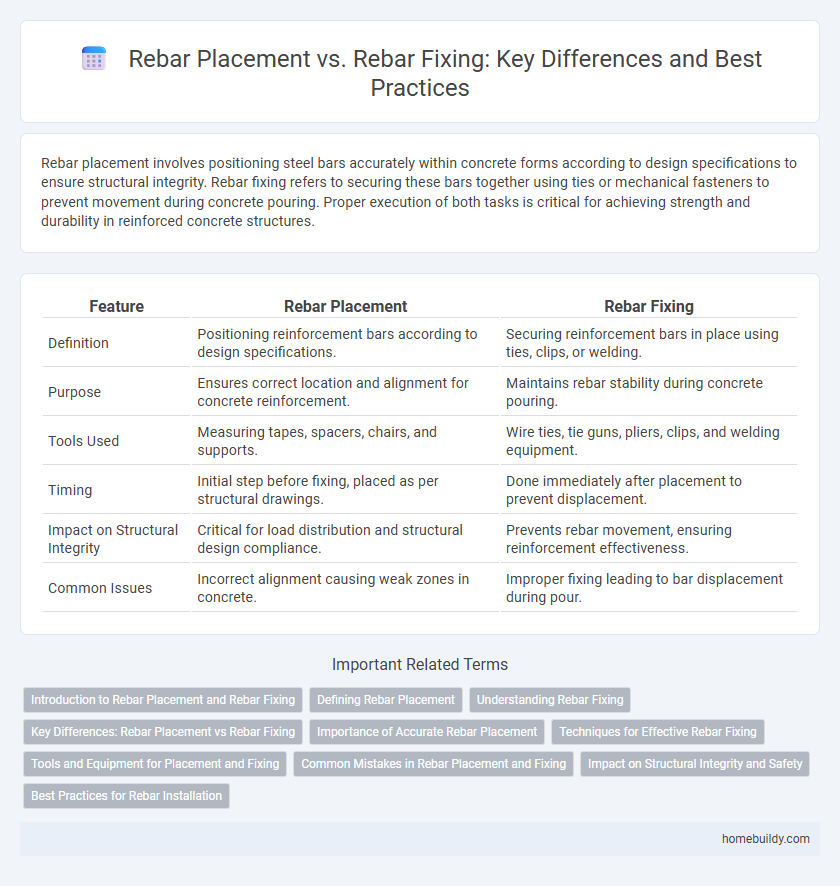Rebar placement involves positioning steel bars accurately within concrete forms according to design specifications to ensure structural integrity. Rebar fixing refers to securing these bars together using ties or mechanical fasteners to prevent movement during concrete pouring. Proper execution of both tasks is critical for achieving strength and durability in reinforced concrete structures.
Table of Comparison
| Feature | Rebar Placement | Rebar Fixing |
|---|---|---|
| Definition | Positioning reinforcement bars according to design specifications. | Securing reinforcement bars in place using ties, clips, or welding. |
| Purpose | Ensures correct location and alignment for concrete reinforcement. | Maintains rebar stability during concrete pouring. |
| Tools Used | Measuring tapes, spacers, chairs, and supports. | Wire ties, tie guns, pliers, clips, and welding equipment. |
| Timing | Initial step before fixing, placed as per structural drawings. | Done immediately after placement to prevent displacement. |
| Impact on Structural Integrity | Critical for load distribution and structural design compliance. | Prevents rebar movement, ensuring reinforcement effectiveness. |
| Common Issues | Incorrect alignment causing weak zones in concrete. | Improper fixing leading to bar displacement during pour. |
Introduction to Rebar Placement and Rebar Fixing
Rebar placement involves accurately positioning reinforcement bars within concrete forms based on structural drawings to ensure the designed load-bearing capacity. Rebar fixing refers to securely tying or fastening bars together using wire or mechanical fasteners to maintain their position during concrete pouring. Proper coordination between placement and fixing is essential to uphold structural integrity and compliance with engineering specifications.
Defining Rebar Placement
Rebar placement refers to accurately positioning reinforcement bars within a concrete formwork according to structural design specifications to ensure optimal load-bearing capacity and durability. It involves aligning the bars at precise intervals, maintaining correct cover, and securing them before concrete pouring to prevent displacement. Proper rebar placement is critical for achieving the intended structural integrity and complying with construction standards.
Understanding Rebar Fixing
Rebar fixing involves securely tying reinforcement bars together to maintain their position during concrete pouring, ensuring structural integrity and load distribution. Proper rebar fixing prevents displacement caused by concrete flow or construction activity, which is critical for meeting design specifications and safety standards. Unlike rebar placement, which focuses on positioning, fixing emphasizes stability and adherence to engineering requirements through techniques such as wire tying or mechanical fasteners.
Key Differences: Rebar Placement vs Rebar Fixing
Rebar placement involves positioning reinforcement bars within the concrete structure according to design specifications, ensuring correct spacing, alignment, and orientation to provide structural integrity. Rebar fixing refers to the process of securing the placed bars using ties, chairs, or spacers to maintain their position during concrete pouring and curing, preventing displacement due to vibrations or load. The key difference lies in placement being the initial arrangement of bars and fixing as the method to stabilize and hold the reinforcement in place during construction.
Importance of Accurate Rebar Placement
Accurate rebar placement ensures structural integrity by maintaining the designed positioning and spacing critical for load distribution and concrete bonding. Precise placement minimizes risks of concrete cover reduction, corrosion, and structural failures, directly impacting the durability and safety of reinforced concrete elements. Proper alignment and securing of rebar during fixing support the intended structural design, preventing displacement during concrete pouring and curing.
Techniques for Effective Rebar Fixing
Rebar fixing techniques involve securing reinforcement bars at precise locations using methods such as wire tying, mechanical couplers, or plastic spacers to maintain structural integrity during concrete pouring. Proper fixing ensures correct rebar placement, preventing displacement and enhancing load distribution within the concrete structure. Mastery of effective rebar fixing techniques contributes to optimized construction quality and compliance with engineering standards.
Tools and Equipment for Placement and Fixing
Rebar placement involves positioning steel bars accurately within concrete forms using tools like rebar chairs, spacers, and laser levels to ensure proper alignment and spacing. Rebar fixing requires securing bars together employing equipment such as tying tools, wire cutters, and binding wires for stability during concrete pouring. Both processes rely on specialized tools tailored for precision and durability to maintain structural integrity.
Common Mistakes in Rebar Placement and Fixing
Common mistakes in rebar placement include incorrect positioning, insufficient cover, and inadequate overlap length, which compromise structural integrity and durability. In rebar fixing, errors such as loose ties, improper spacing, and lack of secure fastening can lead to displacement during concrete pouring, affecting load distribution. Ensuring precise adherence to design specifications and using appropriate fixing techniques mitigates risks of structural failure.
Impact on Structural Integrity and Safety
Rebar placement ensures the correct positioning of reinforcement bars as per design specifications, directly influencing structural load distribution and overall stability. Rebar fixing secures these bars firmly in place, preventing displacement during concrete pouring, which is crucial for maintaining intended structural integrity. Improper placement or fixing can lead to reduced load-bearing capacity, increased risk of cracks, and potential safety hazards in reinforced concrete structures.
Best Practices for Rebar Installation
Proper rebar placement ensures structural integrity by positioning reinforcement bars accurately according to design specifications, preventing movement during concrete pouring. Rebar fixing involves securely tying bars together using wire ties or mechanical fasteners to maintain spacing and alignment under construction loads. Best practices for rebar installation emphasize consistent cover, accurate positioning, and firm fixing to avoid displacement and ensure durability of concrete structures.
Rebar placement vs Rebar fixing Infographic

 homebuildy.com
homebuildy.com